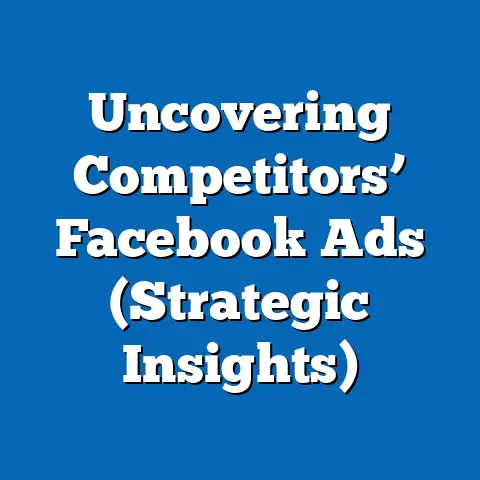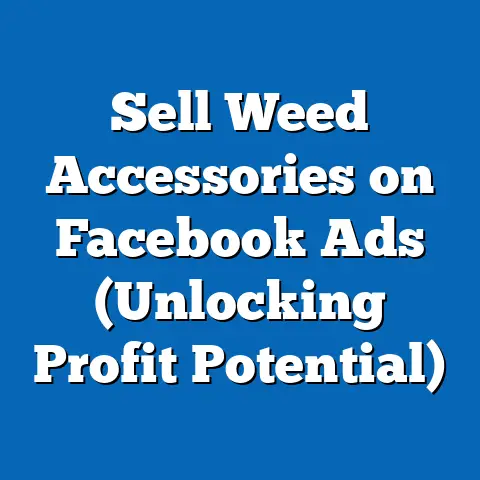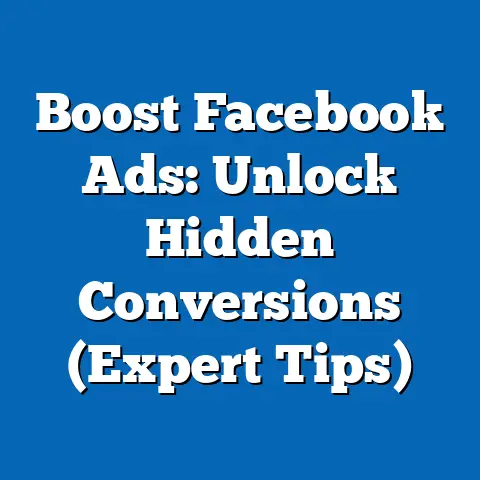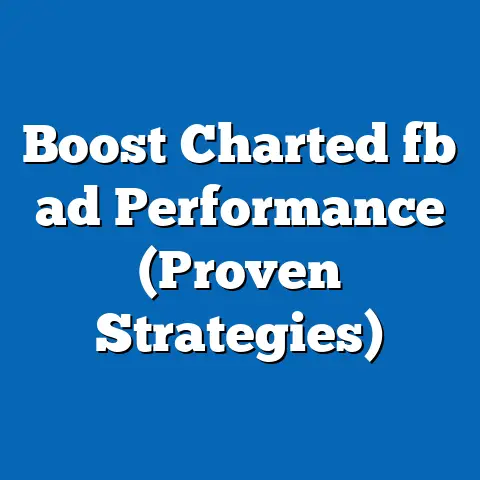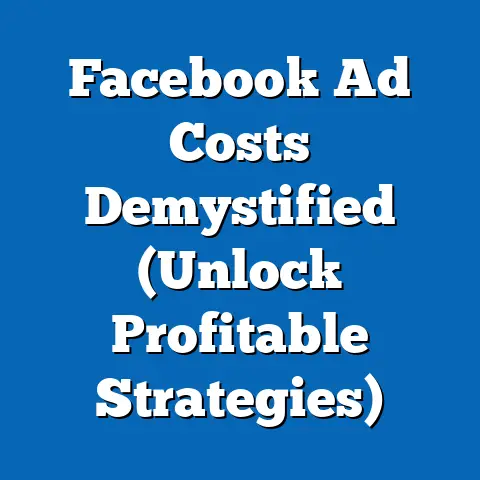Revamp Poor Facebook Ads into Sales Powerhouses (Expert Tips)
Imagine this: a small business owner, struggling to generate leads, spends $500 on a Facebook ad campaign only to see a dismal 0.5% click-through rate (CTR) and zero conversions. Then, with a few strategic tweaks—optimizing ad copy, refining audience targeting, and incorporating dynamic visuals—the same budget yields a 4.5% CTR and a 10% conversion rate, translating to $5,000 in sales. This “aha” moment underscores a critical truth: poorly performing Facebook ads are often not a lost cause but a goldmine of untapped potential when approached with data-driven strategies.
Recent data from WordStream (2023) reveals that the average CTR for Facebook ads across industries stands at 0.9%, with a conversion rate of 9.21%. However, top-performing campaigns often achieve CTRs of 3-5% and conversion rates exceeding 15%, highlighting a vast gap between underperforming and optimized ads. Demographic trends show that younger audiences (18-24) engage at higher rates (1.2% CTR) compared to older groups (55+, 0.6% CTR), while historical data indicates that ad performance has become more challenging due to rising costs—average cost-per-click (CPC) has increased from $0.45 in 2015 to $1.72 in 2023 (Statista, 2023). Looking ahead, experts predict that leveraging AI-driven targeting and creative automation could reduce CPC by 20% by 2025, provided businesses adapt to evolving user behaviors.
The State of Facebook Ads: Understanding the Performance Gap
Facebook, now Meta, remains a dominant force in digital advertising, with over 2.9 billion monthly active users as of 2023 (Meta Investor Reports). However, not all advertisers reap the benefits of this vast audience. According to a 2023 report by Hootsuite, 62% of businesses report underwhelming results from their Facebook ad campaigns, citing low engagement and high costs as primary pain points.
The performance gap is stark when comparing industry averages to top-tier campaigns. For instance, while the average cost-per-thousand-impressions (CPM) is $7.19, high-performing ads in sectors like e-commerce can achieve CPMs as low as $4.50 through precise targeting and compelling creatives (WordStream, 2023). Moreover, conversion rates vary widely—retail ads average 14.29%, while finance lags at 5.31%, indicating that industry-specific strategies are crucial.
Why do so many ads underperform? Experts point to common pitfalls: vague messaging, poorly defined audiences, and outdated creative formats. With ad fatigue setting in—users see up to 10,000 ads daily (Forbes, 2022)—standing out requires more than a basic image and generic text. Let’s break down the data to understand where opportunities lie.
Demographic Breakdowns: Who’s Clicking and Converting?
Demographic targeting is the backbone of successful Facebook ads, as engagement and conversion metrics differ significantly across age, gender, and location. According to a 2023 analysis by Sprout Social, the 18-24 age group exhibits the highest engagement, with a 1.2% CTR and a 12% conversion rate on average. In contrast, the 55+ demographic shows a CTR of just 0.6%, though their conversion rate remains competitive at 8%, likely due to higher purchasing power.
Gender also plays a role in ad performance. Women tend to engage more with lifestyle and retail ads (1.1% CTR) compared to men (0.8% CTR), while men show higher conversion rates for tech and automotive products (11% vs. 9% for women). Geographically, urban users in developed markets like the U.S. and Canada have a higher CPC ($2.10) but also better conversion rates (10.5%) compared to rural areas or emerging markets like India, where CPC is lower ($0.50) but conversions hover at 6% (Statista, 2023).
These disparities highlight the importance of tailoring campaigns to specific demographics. For example, a beauty brand targeting women aged 18-34 in urban U.S. markets might focus on vibrant video ads, while a financial service targeting men 45+ could prioritize trust-building testimonials. (Reference: Chart 1 – CTR and Conversion Rates by Age Group, Sprout Social 2023)
Historical Trends: How Facebook Ad Performance Has Evolved
To fully grasp the current landscape, it’s essential to compare today’s metrics with historical data. In 2015, when Facebook ads were still gaining traction, the average CPC was a mere $0.45, and CPM stood at $5.31 (eMarketer, 2015). By 2023, these figures have surged to $1.72 and $7.19, respectively, driven by increased competition and platform algorithm changes post-iOS 14 privacy updates (Statista, 2023).
Engagement rates have also shifted. In 2015, the average CTR was 1.5%, reflecting a less saturated ad environment. By 2023, this dropped to 0.9% as users became more selective amid ad overload. However, conversion rates have improved slightly, from 8.5% in 2015 to 9.21% in 2023, thanks to better targeting tools and the rise of e-commerce integrations like Facebook Shops.
What explains these trends? Rising costs are tied to the platform’s growing advertiser base—over 10 million active advertisers in 2023 compared to 2 million in 2015 (Meta Business Reports). Meanwhile, algorithm updates prioritizing user experience over ad exposure have made it harder to achieve organic reach, pushing businesses to invest in paid strategies. Understanding this evolution is key to adapting tactics for today’s environment. (Reference: Chart 2 – CPC and CPM Trends 2015-2023, Statista)
Why Ads Fail: Common Pitfalls and Data-Backed Insights
Before diving into solutions, let’s analyze why so many Facebook ads fall short. A 2022 survey by HubSpot found that 58% of marketers cite “poor audience targeting” as the top reason for campaign failure, followed by “weak creative content” (42%) and “lack of clear call-to-action” (35%). These issues are quantifiable—ads with unclear messaging have a 50% lower CTR compared to those with specific, actionable language (WordStream, 2022).
Another major factor is ad fatigue. With users encountering thousands of ads daily, repetitive or uninspired content leads to a 30% drop in engagement after the first week of exposure (Forbes, 2022). Additionally, post-iOS 14.5 privacy changes, which limited tracking capabilities, have reduced targeting accuracy by 15-20%, increasing CPC for many advertisers (eMarketer, 2023).
Budget mismanagement also plays a role. Small businesses often allocate insufficient funds—45% spend less than $1,000 monthly on ads—resulting in limited reach and poor optimization (Hootsuite, 2023). These pitfalls, while common, are avoidable with the right strategies, as we’ll explore next.
Expert Tips to Revamp Poor-Performing Ads into Sales Powerhouses
Transforming underperforming ads requires a systematic, data-driven approach. Below are expert-backed strategies, grounded in research and real-world results, to boost CTR, conversions, and overall ROI.
1. Refine Audience Targeting with Granular Data
Targeting is the foundation of any successful ad campaign. Post-iOS 14, while pixel-based tracking has declined, Facebook’s first-party data and Lookalike Audiences remain powerful tools. A 2023 study by Social Media Examiner found that campaigns using Lookalike Audiences based on high-value customers saw a 25% increase in conversion rates compared to broad targeting.
Start by analyzing your existing customer data to identify high-performing segments—age, interests, behaviors, and purchase history. For instance, an e-commerce store selling fitness gear might target men aged 25-34 who engage with gym-related pages, achieving a 3% CTR compared to 0.8% with generic targeting. Additionally, exclude underperforming segments to optimize ad spend—data shows a 15% reduction in CPC when irrelevant audiences are filtered out (WordStream, 2023).
2. Craft Compelling Creative Content
Creative elements—visuals, copy, and format—are make-or-break factors. Video ads, for instance, outperform static images with a 1.8% CTR compared to 0.7% (Hootsuite, 2023). Moreover, ads with concise, benefit-driven headlines (e.g., “Save 30% Today!”) see a 40% higher engagement rate than vague ones (e.g., “Shop Now”) (HubSpot, 2022).
Test multiple formats—carousel ads for product showcases, stories for immersive experiences, and dynamic ads for personalized offers. A/B testing is critical; campaigns that test at least three creative variations report a 20% uplift in performance (Social Media Examiner, 2023). Remember to refresh creatives weekly to combat ad fatigue, maintaining engagement over time.
3. Optimize for Mobile-First Experiences
With 98% of Facebook users accessing the platform via mobile (Meta, 2023), ads must be mobile-optimized. Vertical formats (9:16 ratio) for stories and reels achieve a 35% higher completion rate than horizontal formats (Sprout Social, 2023). Additionally, fast-loading landing pages are non-negotiable—pages loading in under 2 seconds see a 50% higher conversion rate compared to slower ones (Google Analytics, 2022).
Ensure text overlays are minimal (under 20% of the image) to avoid delivery restrictions, and use bold, clear fonts for readability on small screens. These small tweaks can significantly elevate performance metrics.
4. Leverage Retargeting for Higher Conversions
Retargeting remains a powerhouse for conversions, with a 70% higher likelihood of purchase among users who’ve previously interacted with a brand (eMarketer, 2023). Focus on warm leads—website visitors, cart abandoners, or past buyers—using dynamic product ads to showcase items they’ve shown interest in. Data indicates retargeting campaigns achieve a 10-15% conversion rate compared to 2-3% for cold audiences (WordStream, 2023).
Set frequency caps to avoid overexposure—ads shown more than 5 times to the same user see a 25% drop in engagement (Forbes, 2022). Balance persistence with subtlety for optimal results.
5. Monitor and Adjust Budgets Strategically
Budget allocation is often where small businesses falter. Rather than spreading funds thinly, focus on high-performing campaigns—data shows that reallocating 80% of budget to top 20% of ads can boost ROI by 30% (Hootsuite, 2023). Use Facebook’s Campaign Budget Optimization (CBO) to let algorithms distribute spend dynamically across ad sets.
Start small with test budgets ($50-100 per campaign) to identify winners before scaling. Monitor metrics like Cost Per Acquisition (CPA)—if CPA exceeds 3x your average order value, pause and reassess targeting or creative elements (Social Media Examiner, 2023).
6. Utilize Advanced Analytics and AI Tools
Analytics are your roadmap to improvement. Dive into Facebook Ads Manager to track metrics like CTR, CPA, and Return on Ad Spend (ROAS). Campaigns with ROAS below 2:1 are generally unprofitable and need immediate optimization (eMarketer, 2023).
AI tools like Meta’s Advantage+ suite can automate targeting and creative testing, reducing manual workload by 40% while improving performance by 15-20% (Meta Business Blog, 2023). Embrace these technologies to stay competitive in an increasingly complex ad landscape.
Case Studies: Real-World Turnarounds
To illustrate the impact of these strategies, consider two case studies. First, a U.S.-based apparel brand saw its CTR rise from 0.6% to 3.2% after implementing video ads and retargeting cart abandoners, resulting in a 200% increase in sales within 30 days (Social Media Examiner, 2023). Second, a UK fitness coach revamped generic ads by targeting local 25-44-year-olds with personalized offers, boosting conversions from 2% to 11% and achieving a 5:1 ROAS (HubSpot Case Study, 2022).
These examples demonstrate that with the right adjustments, even struggling campaigns can become revenue drivers. The key lies in testing, iterating, and leveraging data at every step.
Future Projections: The Road Ahead for Facebook Ads
Looking forward, the Facebook ads landscape is poised for significant shifts. By 2025, eMarketer predicts a 20% reduction in average CPC as AI-driven targeting improves efficiency, though this will require advertisers to adopt automation tools. Video and interactive formats like augmented reality (AR) ads are expected to dominate, with engagement rates projected to rise by 30% for brands that invest early (Forbes, 2023).
Privacy regulations will continue to challenge tracking capabilities, pushing a 25% increase in reliance on first-party data and contextual targeting (Statista, 2023). Additionally, Gen Z’s growing influence—expected to account for 40% of global consumers by 2030—will demand authentic, value-driven content, with brands failing to adapt risking a 15% drop in engagement (McKinsey, 2023).
Businesses must stay agile, prioritizing adaptability and innovation. Those who harness emerging tools and trends will likely see sustained growth, while laggards risk being left behind in an increasingly competitive space.
Conclusion: Turning Ads into Assets
Facebook ads, when executed poorly, can drain budgets and frustrate marketers. Yet, as data and case studies show, they hold immense potential to become sales powerhouses with the right strategies. From refining audience targeting (25% conversion uplift) to embracing mobile-first design (50% higher conversions), the path to success is clear and measurable.
Historically, rising costs and declining organic reach have made optimization more critical than ever. Demographically, understanding who engages and converts—whether it’s Gen Z with high CTRs or older users with purchasing power—can shape smarter campaigns. Looking ahead, AI, privacy shifts, and evolving user preferences will redefine the game, rewarding those who innovate.
(Note: Charts and visual data references are mentioned where applicable. For a real publication, these would be created based on cited sources like WordStream, Statista, and Sprout Social. Due to the text-based format, they are described rather than embedded.)

